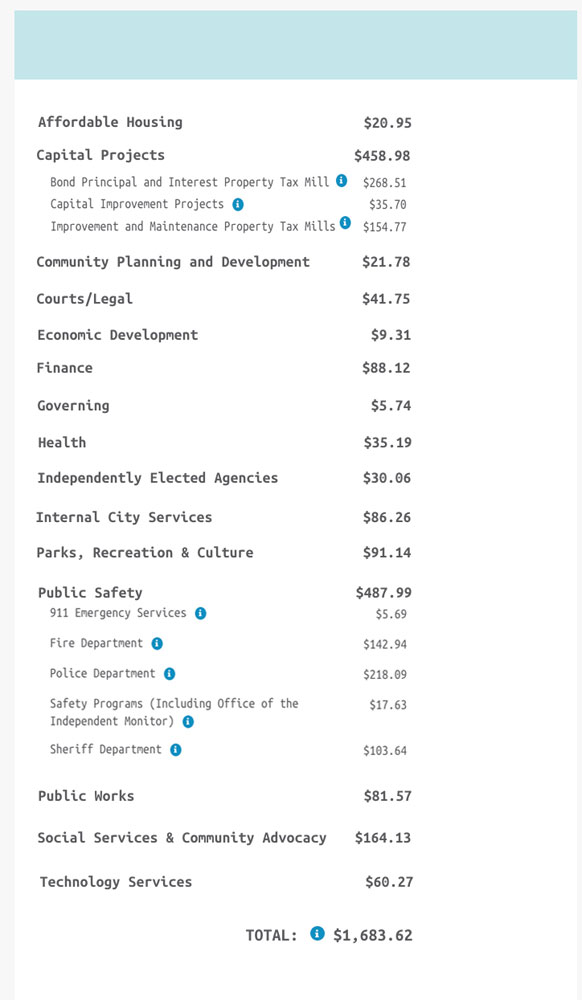“We are all accustomed to getting a receipt when we spend money on just about everything else, so why not get a receipt when you pay your city taxes?” So says Brendan Hanlon, the city of Denver’s chief financial officer. Taxpayer Receipt, a new tool on Denver’s website, makes the city’s budget more transparent by educating residents on how and where their money is spent.

The tax receipt above has been simplified to show primarily main categories, but with subcategories included for the two largest items, Capital Projects and Safety. It is for a 40-year-old who earns $85,000, lives in a $400,000 house, and does 75% of shopping in Denver. Pop out boxes explain the subcategories.
If you want a “receipt” for your Denver taxes, you can now get it by answering four questions: annual income, age, estimated percent of shopping done in Denver for goods and products, and whether you own a home.
The instantaneous output, based on Denver’s 2017 budget, is a long list of how your tax dollars are spent. It’s arranged alphabetically starting with “Affordable Housing” and concluding with “Technology Services.” The 15 major categories cover the wide range of expenses associated with a full-service urban municipality. The list is intended to look like the receipt one might be given at the grocery store and is available in English or Spanish.
The tool works only with Denver sales tax and Denver property tax (currently 30.531 mills). It does not address services and programs that are exclusively supported by non-local tax dollars, such as federal or state grants. Additionally, taxes paid that support other entities, such as the state or federal governments, Denver Public Schools and special districts are excluded. Those, of course, can be significant. For example, the DPS mill levy is 50.396 and the special district mill levy for Stapleton infrastructure (Westerly Creek Metropolitan District) currently stands at 56.899 mills. Other entities, such as the Scientific and Cultural Facilities District, apply a small sales tax to purchases in Denver.
Those exclusions represent an opportunity, says Stapleton resident Chris Adams, president of Engaged Public, the firm whose software powers Denver Taxpayer Receipt. He would ultimately like to see taxpayers have access to a unified application that would generate taxpayer “receipts” that cover expenditures made by all taxing entities to which a homeowner is subject. Such information, he said, is critical to achieving “realistic conversations” about tax policy and government budgeting in general.
While the “front end” of the Denver Taxpayer Receipt application is exceedingly simple, the “back end” is more complex. “Dynamic” calculations are made estimating the market basket of goods that a person of a given age and income might purchase within the city limits of Denver. Adams says the opportunity provided by the online calculator to see where tax revenues are spent “may be an encouragement to buy local. Why buy someone else’s sidewalk?”
Search for Taxpayer Receipt at denvergov.org to find where your tax money goes.



I have tried repeatedly to “Search for Taxpayer Receipt at denvergov.org to find where your tax money goes.” and I get no results. Is there a more specific link? I get nowhere. As a real estate professional, I’d like to be able to share this with my clients. Thank you.
https://www.denvergov.org/content/denvergov/en/denver-department-of-finance/taxpayer-receipt.html
It comes right up in a google search for Denver Taxpayer Receipt but it does not come up in a DenverGov.org search. Our apologies, we should have written “search Google.”